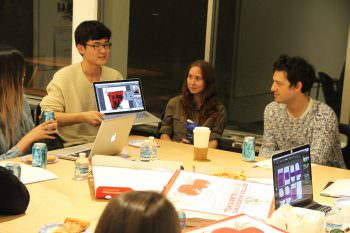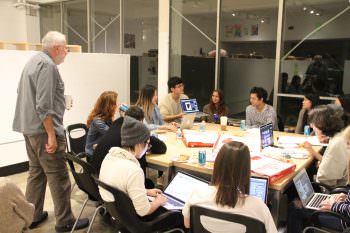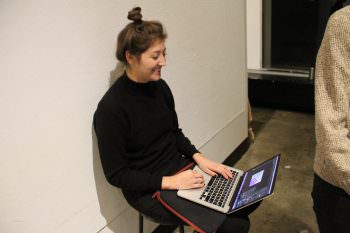As a follow-up to his lecture earlier this semester, David Rudnick returned to CalArts in early December to lead a one-day workshop called “Autonomy & Solidarity.” The workshop explored the designer’s tentative connection with their viewer, and how the designer’s intentions for meaning become altered by the constantly-shifting context of digital media.
In the “autonomy” portion of the workshop, we worked with variables for influencing the viewer’s experience that were within our control as designers. Workshop participants were asked to create a transparent digital image with an original meaning derived from the combination of two seemingly unrelated proper nouns: for the first, the name of an individual, object, or event that embodies some personal significance, and for the second, its conceptual pair. When published, the image would function as a hyperlink to a destination of our choosing on the web, whether it be our portfolio, social media profile, or otherwise.
The “solidarity” portion challenged students to consider the viewer’s experience of their image within the broad and varying context of the digital landscape. In its final form, the product of the workshop will be a collection of visual responses by all participants on a single webpage, whose changing background color will produce a different viewing experience with each visit, as certain images are pushed forward and others recede. In addition to the variable background, the meaning of individual images will also be determined by their relationship to the collection as a whole.
After students identified the subjects of their images, Rudnick encouraged us to take advantage of the workshop as an opportunity to explore a variety of methods for image-making, as well as processes for translating them to a digital environment. The resulting images represented a diversity of approaches that included type-based, image-based, digital, and analog strategies. Images were developed through a series of desk crits, followed by a casual group discussion over pizza.
For me and many other students, the workshop was a valuable exercise that demonstrated some of the unique issues significant to contemporary design practice. A work of graphic design is a vector for meaning that is not only informed by the designer’s intent, but also by its relation to other elements within a shared digital space. Rudnick provided the following example: the way in which an image is read may in part be determined by the content of the posts that bookend it on a Twitter feed.
Although the life experiences of this current generation of designers is deeply integrated with digital media, it, for the most part, occurs in an organic and intuitive manner. Through this workshop, my fellow students and I were challenged to take a considered approach to designing for a digital space, and to embrace variables outside of our control as further opportunities to connect with viewers. In addition to considering the multivalent meanings taken on by a proper noun within a digital context, it is also important for the designers of this generation to think about the act of creating meaning in terms of the infinitive.


